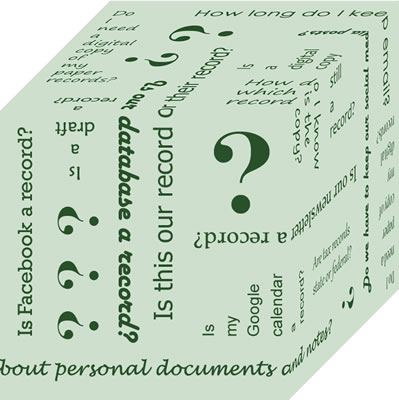
|
Records Management Essentials |
Home  Records Management Essentials
Records Management Essentials  Section 2
Section 2  2.2. Analyzing and assessing your records
2.2. Analyzing and assessing your records
2.2. Analyzing and assessing your records
When beginning an assessment of your agency’s records, it is important to understand what qualifies as a record and what does not. As discussed in the previous section, a government record has three characteristics: it is documentary material, regardless of format, that is prepared, owned, received, or retained by a governmental entity or political subdivision, and is reproducible.1
Government records are prepared by any person who is acting as an official representative of government. Records may be received and/or retained in order to carry out a government function.
Under Utah statute, “record” does NOT include:
- personal communications and papers prepared and received by an employee or officer of a governmental entity while she or he is not acting in a governmental capacity or conducting the public’s business;
- temporary drafts;
- material that has been copyrighted or that belongs to a library collection;
- or proprietary software or a computer program.2
Separating non-records from records is important for good records management. For example, personal emails should not be stored in one’s work email account; personal documents should not be stored on one’s work computer.

The process of determining whether an item is or is not a record can be complicated and misunderstood at times. For instance, if a temporary draft is never destroyed and a final version is not adopted, then the draft ceases to be temporary and may be a record. The second factor in determining if a draft is a record regards the way that it is used and shared. A draft is not considered a record if it is “a provisional, interim, or stopgap rendition of information” created for a government employee’s personal work processes (such as field notes taken in preparation for completing a subsequent report).3 This type of draft is not circulated, stored in a shared document management system, or relied upon for making agency decisions.
Another type of item that can be difficult to identify as a record or non-record is social media. Content on a social media site, such as a blog or Facebook site, that relates to government business is a record and must be treated as such. A wiki may be part of a project file; a blog post may be considered a publication or a press release depending on its content (see the State Archives’ Preliminary Guidance on Government Use of Social Media for more information).
One of the most difficult concepts in defining and recognizing records is understanding databases. Database systems are not records, but they contain distinct records and information which must be managed. People sometimes use the term ‘database’ when referring to the information itself. A database system is like a cupboard, used to store and organize documents or to aggregate tables of data, but a database is not a records management system. It is mandated through law that each state governmental agency establish record retention schedules for any electronic records created or received in an electronic transaction.4 The data held in an agency’s database documents, among other things, business functions and transactions, and may, therefore, be records. Records officers need to have an understanding of what information is contained in their databases, how long it needs to be kept, and how to manage it.
Records can be created and stored as paper, photographs, maps, drawings, microfilm, digital images, spreadsheets, email, databases, tweets, and a variety of other media formats. For the purpose of identifying records, the medium or format is irrelevant; it is the content of the record that is important when determining its value and how long it should be kept. The record should be appraised to determine its administrative, fiscal, legal, and/or historical value, as described in section one, and its retention period should then be based on the appraisal. Transitory records may document official work activities, but they have temporary value and do not need to be retained once their intended purpose has been fulfilled. Transitory records include requests or reminders to do a routine task, simple inquiries about policies, office location and hours, etc. Examples of transitory records include an invitation to a team meeting, an email used to send a document (the attached document will need to be appraised and maintained separately), assignments for the work holiday party, etc.
1Government Records Access and Management Act, Utah Code Ann. §§ 63G-2-103(22)(b) (Supp. 2014). Accessed February 18, 2015. http://le.utah.gov/xcode/Title63G/Chapter2/63G-2-S103.html.
2Ibid.
3Cundiff, Rosemary. "Classifying drafts." Utah Department of Administrative Services, Division of Archives and Records Service. Last modified May 24, 2016. Accessed May 25, 2016. https://archives.utah.gov/opengovernment/classifying-drafts.pdf.
4Uniform Electronic Transactions Act, Utah Code Ann. §§ 46-4-501 (Supp. 2011). Accessed February 18, 2015. http://le.utah.gov/xcode/Title46/Chapter4/46-4-S501.html.